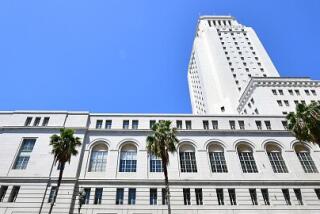Future of Rainbow Coalition, Not Ethics Probe, Shapes Tom Bradley’s L.A.
- Share via
Los Angeles, which once was touted by city leaders as the “white spot of the nation” for its squeaky clean politics, now has earned the dubious distinction as the nation’s “white-out” spot. Last week’s allegation of a bungled cover-up by the city treasurer’s office (the gang that couldn’t white-out straight) to conceal Mayor Tom Bradley’s alleged role in a controversial city bank deposit is only the latest in a litany of financial scandals rocking City Hall. The record over the past several years reveals an apparent ethical hemorrhaging--charges of mismanagement and nepotism in the General Services Department, claims of influence-peddling by some former Bradley aides-turned-lobbyists, and, most serious of all, allegations of conflict of interest against Bradley himself in his dealings as a paid adviser to Far East National Bank.
Once dubbed the Teflon Mayor, Bradley finally appears to be losing his protective coating. The City Council, prodded by press revelations, is no longer automatically mayor-friendly. Council President John Ferraro and Finance and Revenue Committee Chairman Zev Yaroslavsky, both of whom have had their mayoral ambitions frustrated by Bradley’s formidable re-election machine, have taken the lead on the council investigation into charges that Bradley sought special treatment for business associates. Even some staunch Bradley allies now concede the need for a full-fledged independent investigation of the mayor’s troubled financial dealings.
With daily revelations of Bradley’s mounting difficulties, Los Angeles may soon face the difficult political crossroads that insiders thought would be delayed until the 1993 election: the prospects of life in the post-Bradley era. The current controversy involves far more than the mayor’s tangled financial relationships. Weighing in the balance are the larger accomplishments and failures of his 16-year Administration.
First, the notable accomplishments. Under Bradley, Los Angeles has emerged as the nation’s premier city for liberal, ethnic coalition politics. In 1973, a black/Jewish alliance elected Bradley, wresting power from the conservative Sam Yorty regime. Since then, Latinos and Asians have joined the Bradley alliance as junior partners.
The city’s long-lasting liberal rainbow coalition is remarkable in light of the experience of other big cities. In New York, Mayor Ed Koch has fractured the 1960sliberal alliance of Jews, blacks and Latinos that killed efforts to maintain the corrupt Tammany Hall. That alliance elected reformer John Lindsay as mayor in 1965. In Chicago, the alliance of blacks, Latinos and white liberals that elected black reformer Harold Washington mayor in 1983 proved to be short-lived. This year, a victorious Richard M. Daley, son of the late mayor, drew disaffected white liberals and Latinos into his camp.
The Bradley achievement of ethnic inclusion is even more remarkable in light of Los Angeles’ entrenched WASP power structure. A staunchly conservative downtown business Establishment firmly ruled the city from the late 19th Century into the 1960s, waging a successful century-long campaign against liberals, Democrats, minorities and organized labor. Like Daniel in the lions’s den, Bradley soothed the skeptical business community with an ambitious plan for downtown redevelopment. Soon the Establishment applied for full partnership in the Bradley coalition.
To succeed in liberalizing the city’s politics, Bradley also had to combat Los Angeles’ decentralized governmental structure that had placed an inordinate amount of power in the hands of conservative City Council members and unelected administrators. The mayor carefully placed his liberal proteges on the council, enlisting them as allies in an attack on the entrenched city bureaucracy.
The fruits of Bradley’s campaign to place power in the hands of elected officials were manifold--an aggressive strategy to secure federal grants both to rebuild the decaying downtown area and to deliver needed social services to the city’s minority groups; the appointment of minorities and women to top administrative posts; increased minority hiring in municipal employment and contracting, and greater civilian control over the police. Despite his impassive demeanor and seemingly cautious style, the mayor quietly yet courageously captured and transformed a hostile city government. Los Angeles will never be the same again because of Tom Bradley.
However, these impressive accomplishments have to be balanced against the arguable failures of the Bradley era. To many critics, the mayor’s growth policies have produced class polarization and ethnic Balkanization. Developers have been pitted against neighborhood residents, rich pitted against poor and ethnic groups turned against one another as federal funding has dried up.
Whether Bradley survives the current crisis, demographic and economic trends threaten Los Angeles’ version of the rainbow coalition. The Latino and Asian populations, today’s junior partners, are rapidly growing while the black and Jewish populations, its senior partners, have leveled off. At the same time, the city’s class and ethnic dividing lines are hardening. Jews and Asians are riding the waves of Pacific Rim prosperity while many blacks and Latinos constitute a growing underclass trapped by a low-paying service economy. The game of ethnic musical chairs will accelerate as Latinos and Asians seek a greater voice in the city’s affairs.
The financial scandal dominating today’s local political headlines obscures these underlying fissures in the city’s governing ethnic alliance, first revealed in the mayor’s surprisingly narrow 1989 reelection victory. For Bradley, his possible successors and the city’s voters, the big, long-term question is not so much about financial mismanagement in City Hall but the survivability of the rainbow coalition that brought the city its most noteworthy success.
More to Read
Sign up for Essential California
The most important California stories and recommendations in your inbox every morning.
You may occasionally receive promotional content from the Los Angeles Times.










